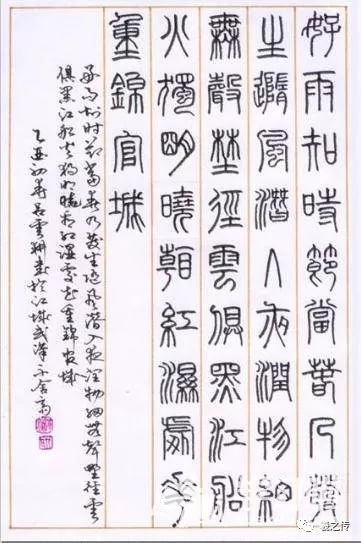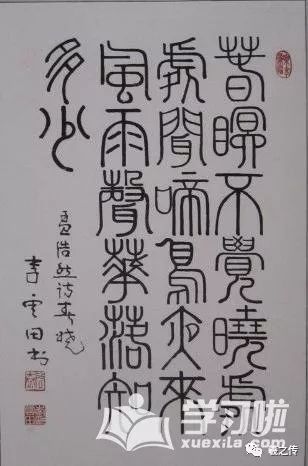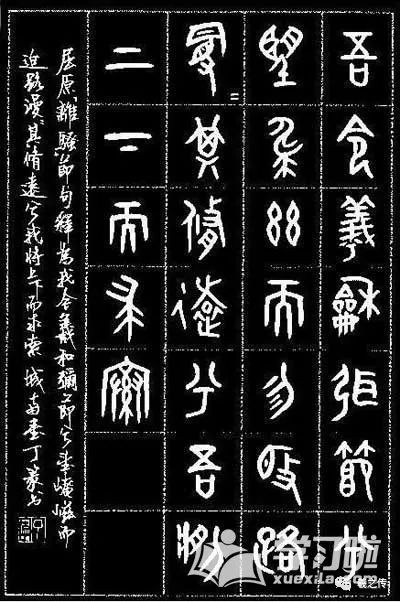 Seal script is a font style in Chinese calligraphy art. This font has a very high characteristic charm and has a great influence on Chinese fonts. Nowadays, calligraphy works of seal script have a very high artistic status in our country. The following are pictures of calligraphy works in seal script font and hard pen that Xiaobian compiled.
Seal script is a font style in Chinese calligraphy art. This font has a very high characteristic charm and has a great influence on Chinese fonts. Nowadays, calligraphy works of seal script have a very high artistic status in our country. The following are pictures of calligraphy works in seal script font and hard pen that Xiaobian compiled.
Appreciation of excellent hard pen calligraphy works in seal script
There are big seal scripts first and then small seal scripts. As early as more than 6,000 years ago, the symbols carved on pottery and the pictures depicting images had the prototype of characters, and then in the long development, pictographic (picture) characters were produced. Three thousand years ago in the Yin and Shang Dynasties, the inscriptions carved on tortoise shells and animal bones, namely "Oracle Bone Inscriptions", were thin, vigorous and straight, with no hesitation or severity in strokes. In the Shang and Zhou dynasties, the inscriptions cast on bronzes such as bells, tripods, coins, and weapons that appeared were called "Jin Wen" or "Zhong Ding Wen". Calligraphy is becoming more and more neat, the style is round and thick, and the fonts are varied and uneven. During the Spring and Autumn Period and the Warring States Period, the characters carved on stone gui and stone drums were called Shiguwen. The strokes are strong and dignified, the structure is slightly square, and the style is elegant and magnificent. The oracle bone inscriptions, bronze inscriptions, and stone drum inscriptions mentioned above were called Dazhuan in the Qin Dynasty.




Exquisite hard pen calligraphy pictures of seal script
In the pre-Qin Fuxi period in China, writing was produced. Archaeologists have proved that it is oracle bone inscriptions carved on tortoise shells and animal bones. Because it is used for divination and prediction of good and bad fortune, it is called "Inscriptions". But it already has the basic elements of Chinese calligraphy art: brush, structure, composition, etc. During the Yin and Zhou dynasties, the inscriptions cast and engraved on the Zhongding Yi vessels, that is, the bronze inscriptions, also known as "Zhongdingwen", were widely popular.




Definition of Zhuan seal
It is actually the same as '籀文', that is, 'big seal script'. However, Zhang Huaiguan of the Tang Dynasty listed "Zi Wen" and "Da Zhuan" in the volume of "Book Break", and believed that "Zi Wen was written by Zhou Taishi Zhenzhi, which is different from the ancient Chinese seal script". Zhao Huanguang of the Ming Dynasty also holds this view in "Quan and Yi" in the volume of "Han Shan Broom Talk", thinking that in the seal script, "Zi Zhuan", "Curse Chu Wen", "Zhong Ding Shi", and "Xiao Tang Lu" , and even Yang's "Shu Tong" and the rhymes of ancient seal characters, whichever is the same as Xu's "Zi Shu" are adopted. One is called "big seal script", which is also true in "Stone Drum Wen". According to this, the "籀端" mentioned by the Zhao family is mostly the same as the "Bronze Inscription". Duan Yucai of the Qing Dynasty tried his best to distinguish the fallacy in the annotation of "Shuowen Jiezi·Xu", and believed that "Zizhuan" is actually "Dazhuan". Recently, scholars have made a compromise between the two, and believe that there are still differences between "Zi Zhuan" and "Da Zhuan" (mainly referring to "Shigu Wen") in terms of fonts. Therefore, for example, Zhao Huanguang and others listed "Zhuan Zhuan" in addition to "Da Zhuan", and the theory is also valid.

Currently 100000+ people have followed us




Articles are uploaded by users and are for non-commercial browsing only. Posted by: Lomu, please indicate the source: https://www.daogebangong.com/en/articles/detail/Seal%20script%20font%20hard%20pen%20calligraphy%20works%20picture.html

 支付宝扫一扫
支付宝扫一扫 
评论列表(196条)
测试